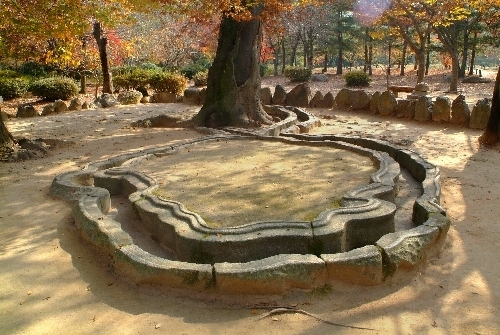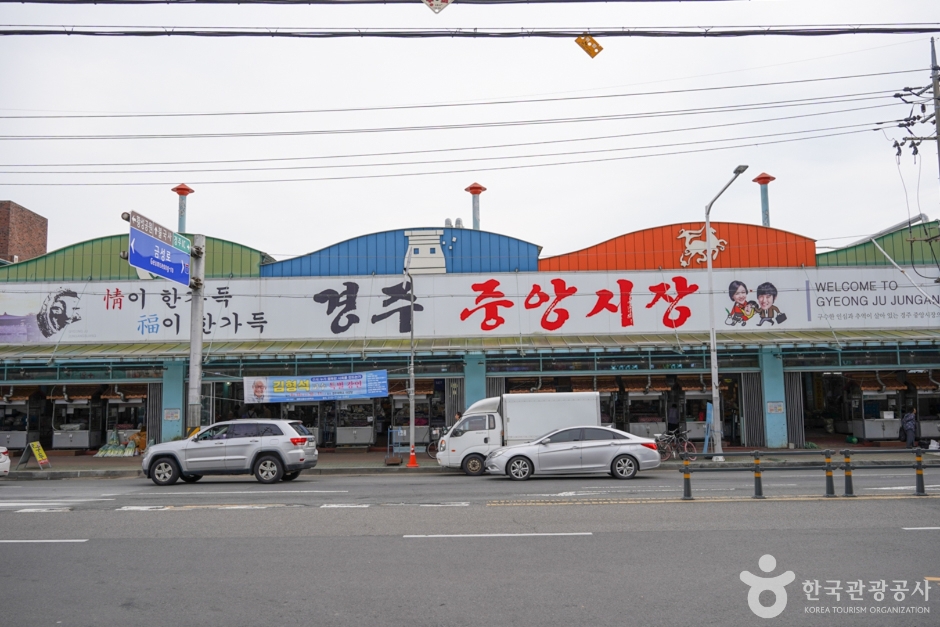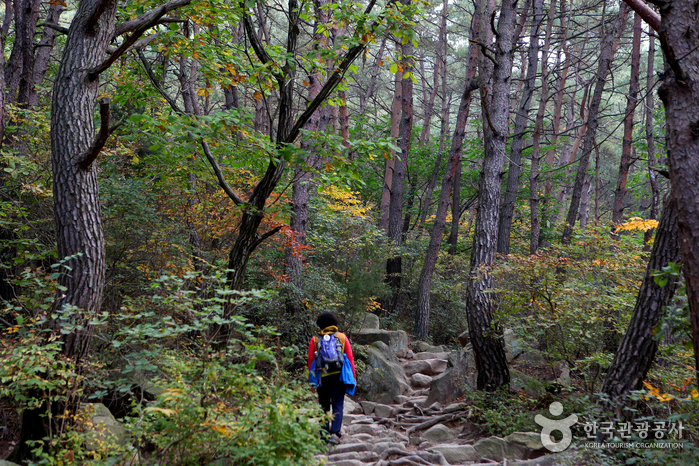Gyeongju Seokguram Grotto [UNESCO World Heritage] (경주 석굴암 [유네스코 세계유산])
7.3Km 2025-06-12
238 Seokgul-ro, Gyeongju-si, Gyeongsangbuk-do
+82-54-746-9933
Seokguram Grotto was constructed by Kim Dae-Seong during the reign of King Gyeongdeok (742-765) of the Silla Kingdom. Located 3 kilometers away by hiking trail and 9 kilometers by car from Bulguksa Temple, the grotto was designed very harmoniously with the seated Buddha facing the East Sea. It is a valuable cultural heritage that is preserved and registered as a UNESCO World Heritage on December 6, 1995.
Gyeongju Poseokjeong Pavilion Site (경주 포석정지)
7.3Km 2020-10-06
816, Namsansunhwan-ro, Gyeongju-si, Gyeongsangbuk-do
+82-54-745-8484
Poseokjeong Pavilion served as a separate palace where kings enjoyed banquets with nobles. The building no longer exists, but the abalone-shaped stone water canal still remains, speculated to have been built during the Unified Silla period although the exact year is unknown. The water canal has an estimated length of 10 meters, with a x_width of approximately 35 centimeters and an average depth of 26 centimeters. Based on Chinese writings from 353, it is said that drinking glasses were floated on the canal. One popular party game had guests creating poems before the glass had passed nine sections of the canel. Guests who could not do this had to drink three glasses. Modern research has shown that the site was not merely a place for fun, but also served as a meeting venue for the royal family, as well as for holding memorial services.
Homeplus - Gyeongju Branch [Tax Refund Shop] (홈플러스 경주)
7.3Km 2024-04-22
97, Gongdan-ro, Gyeongju-si, Gyeongsangbuk-do
-
Hanok Stay Sohwa [Korea Quality]한옥스테이 소화[한국관광 품질인증]
7.3Km 2024-08-14
5 , Gukdang 2-gil, Gyeongju-si, Gyeongsangbuk-do
+82-507-1325-7205
Hanok Stay Sohwa near the famous Hwangnidan-gil in Gyeongju, Gyeongsangbuk-do, is a modern hanok that opened its doors in 2022, and combines tradition with sophistication. Accommodation consists of a living room, two sleeping rooms (bedroom and ondol), two bathrooms and a kitchen, plus an outdoor terrace and a heated mini swimming pool. Visitors will find rest and comfort here, however busy and stressed they were when they set out. The hanok stay only accepts bookings from one group per day.
Sinseonam Hermitage Rock-carved Bodhisattva in Namsan Mountain of Gyeongju (경주 남산 신선암 마애보살반가상)
7.4Km 2020-04-04
Namsan-dong, Gyeongju-si, Gyeongsangbuk-do
+82-54-779-6100
This 1.4 m-high rock-carved Bodhisattva was carved on the southern rock standing right above Chilburam Rock on Namsan Mountain, which may be regarded as a repository of relics and artifacts including Buddha statues spanning the Three Kingdoms Period to the late Unified Silla Period.
Judging from the three-sided bejeweled crown he’s wearing on his head, this is clearly a Bodhisattva statue. He looks as if he is sitting on a cloud, while the closed eyes on the plump face give the impression that he is lost in deep thought. He seems to be watching mankind from his world above the clouds. He is holding a flower in his right hand and his left hand is held up to his chest as if he is preaching.
His robe is very thin, revealing the curves of the body, and hangs down to the base of the pedestal. The mandorla (Buddhist halo of light), which consists of both the dugwang (light radiating from the head) and hte singwang (light emanating from the Buddha’s body), is also the shrine for the statue, so the image of the Bodhisattva looks more prominent. It is presumed that this rock-carved Bodhisattva was made during the late eighth century during the Unified Silla dynasty.
Gyeongju Jungang Market (경주 중앙시장)
7.4Km 2025-05-21
295 Geumseong-ro, Gyeongju-si, Gyeongsangbuk-do
+82-54-743-3696
Opened in 1983, Gyeongju Jungang Market is the main marketplace for Gyeongju locals. Nearly 700 stores selling clothing, oils, rice cakes, vegetables, general goods, and meat operate with some 2,000 vendors. The market is open nearly every day, with the busiest days being those ending in a 2 or 7. The night market, open from Thursday to Sunday, is especially popular among both tourists and locals.
Gyeongju Namsan Mountain (경주 남산)
7.5Km 2024-02-27
Namsan Mountain of Gyeongju (경주 남산)
+82-54-771-7142
Namsan Mountain of Gyeongju is a 466-meter mountain located south of the Gyeongju city center. Gyeongju was the capital of the Silla dynasty (BC 57-AD 935) from its inception to its end. The Silla people revered this mountain, considering it sacred, and left many traces of their presence, resulting in numerous cultural relics that still exist today. Therefore, visitors can enjoy both hiking and cultural heritage sightseeing on this mountain.
Maison Mini Hotel [Korea Quality]메종미니호텔[한국관광 품질인증]
7.5Km 2023-05-23
24 , Taejong-ro 699beon-gil, Gyeongju-si, Gyeongsangbuk-do
+82-54-745-3232, +82-10-3517-6319
The Maison Mini Hotel in Gyeongju, Gyeongsangbuk-do, is 10 minutes’ walk from both Gyeongju Express Bus Terminal and the famous Hwangnidan Street. Rooms are comfortable and clean - they’re inspected by a room manager before each booking - and bedding is changed every day. There is a luggage storage room and a shared kitchen on the first floor.
Blau [Korea Quality]블라우[한국관광 품질인증]
7.6Km 2023-05-23
31 , Taejong-ro 699beon-gil, Gyeongju-si, Gyeongsangbuk-do
+82-10-8590-5808
Blau is a stylish guest house on Hwangnidan-gil, Gyeongju, Gyeongsangbuk-do, whose wooden furniture and signature blue coloring inside and out (‘blau’ is German for ‘blue’) give it a strong European vibe. The first floor lounge has the feel of a spacious cafe. Blau is 5 minutes’ walk from Gyeongju Express Bus Terminal. Luggage storage and a free breakfast can be provided, but guests should ask in advance.
Casa Mini Hotel [Korea Quality]까사미니호텔[한국관광 품질인증]
7.6Km 2023-05-23
28, Geumseong-ro 259beon-gil, Gyeongju-si, Gyeongsangbuk-do
+82-54-777-3355
Casa Mini Hotel in downtown Gyeongju, Gyeongsangbuk-do, is a recently-renovated, clean and tidy hotel that’s well positioned for visits to Gyeongju’s historic sites and tourist attractions. Cheomseongdae Observatory, Donggung Palace and Wolji Pond, Woljeonggyo Bridge and Gyeongju National Museum are all within walking distance. Transport links are good too: Gyeongju Intercity Bus Terminal is a 3-minute walk away.


![Homeplus - Gyeongju Branch [Tax Refund Shop] (홈플러스 경주)](http://tong.visitkorea.or.kr/cms/resource/40/2883740_image2_1.jpg)
![Hanok Stay Sohwa [Korea Quality]한옥스테이 소화[한국관광 품질인증]](http://tong.visitkorea.or.kr/cms/resource/72/2948972_image2_1.jpg)


![Maison Mini Hotel [Korea Quality]메종미니호텔[한국관광 품질인증]](http://tong.visitkorea.or.kr/cms/resource/78/2949378_image2_1.jpg)
![Blau [Korea Quality]블라우[한국관광 품질인증]](http://tong.visitkorea.or.kr/cms/resource/10/2949210_image2_1.jpg)
![Casa Mini Hotel [Korea Quality]까사미니호텔[한국관광 품질인증]](http://tong.visitkorea.or.kr/cms/resource/62/2949262_image2_1.jpg)
 English
English
 한국어
한국어 日本語
日本語 中文(简体)
中文(简体) Deutsch
Deutsch Français
Français Español
Español Русский
Русский